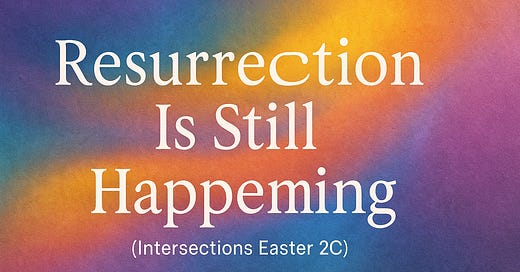Resurrection Is Still Happening!
Intersections for the Second Sunday of Easter, Year C
Resurrection Is Still Happening
Easter wasn’t the end of the story—it was the spark.
This week’s Scriptures remind us that resurrection isn’t a one-time miracle to be remembered; it’s a movement that keeps breaking into locked rooms, courtrooms, grieving hearts, and gasping lungs.
Jesus appears not in grandeur, but through scars and breath. Peter speaks resurrection in defiance of power. The psalmist shouts, “I will not die, but live.” Even the book of Revelation begins not with fear, but with grace and peace from the One who is and is coming.
Resurrection isn’t always loud. It often whispers. It shows up in cracked voices, trembling hands, stubborn joy, and deep breath.
This is the witness of Easter:
Love will not stay buried.
Not then.
Not now.
Not ever.
1. Resurrection Is Ongoing
Resurrection isn’t a past event—it’s a present and unfolding reality. Each passage invites us to notice how new life is still being born in the midst of fear, rejection, and resistance.
John 20:19–31 – Jesus breathes peace into fear and shows that resurrection still carries wounds.
Acts 5:27–32 – The apostles speak resurrection truth in the face of violent power, refusing to go back to silence.
Revelation 1:4–8 – Jesus is described not just as risen, but reigning—the One who was, is, and is coming.
Psalm 118:14–29 – The psalmist declares, “I will not die, but live,” proclaiming that joy rises from suffering.
Psalm 150 – Praise is what resurrection breath sounds like: everything that breathes is included.
2. God Builds with What the World Rejects
From Jesus to the apostles to the psalmist’s rejected stone, this week’s texts affirm that God consistently chooses the overlooked, the cast out, and the silenced to reveal divine love and power.
Psalm 118:22 – “The stone the builders rejected has become the cornerstone.”
John 20:19–31 – Thomas, often shamed as a doubter, is honored with a personal encounter and sacred invitation.
Acts 5:27–32 – Peter and the apostles, seen as troublemakers, are actually God’s witnesses.
Revelation 1:7 – The One who was pierced is the One everyone will see—God’s glory shines through woundedness.
3. Peace Emerges Through Wounds
These passages don’t skip over pain—they hold it with reverence. Resurrection doesn’t erase suffering; it transforms it. Peace isn’t the absence of conflict, but the presence of Christ in our most vulnerable places.
John 20:20 – “He showed them his hands and his side.” Peace is spoken after the scars are revealed.
Revelation 1:5 – Jesus is “the faithful witness,” whose love freed us through suffering.
Psalm 118:18 – “The Lord has punished me severely, but he did not let me die.” Pain does not have the final say.
4. Witness Is the Church’s Calling
To follow Jesus is to testify—not just with words, but with how we live. These texts model boldness, honesty, and a refusal to keep quiet when love is at stake.
Acts 5:32 – “We are witnesses of these things, and so is the Holy Spirit.”
John 20:21 – “As the Father has sent me, so I send you.” Resurrection leads to commissioning.
Psalm 118:17 – “I will live to tell what the Lord has done.” Testimony is worship.
Revelation 1:6 – We have been made “a kingdom of priests.” Not passive believers, but active witnesses.
5. Praise Is for Every Breath
The culmination of resurrection isn’t triumphalism—it’s praise. Not because the world is fixed, but because we are learning to see God’s presence in every breath, every scar, every step toward healing.
Psalm 150 – “Let everything that breathes praise the Lord.” Breath itself becomes a hallelujah.
Psalm 118 – “This is the day the Lord has made. We will rejoice and be glad in it.”
John 20 – Jesus breathes the Spirit on his followers—a sacred exhale of life and mission.
Revelation 1 – Worship frames the entire letter—it’s both resistance and reverence.






